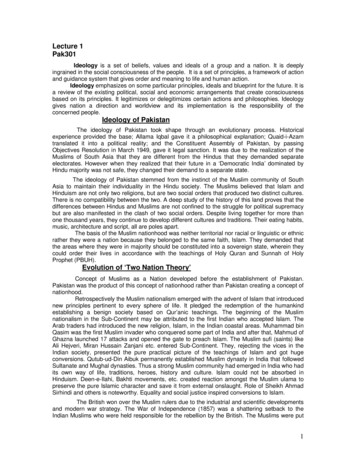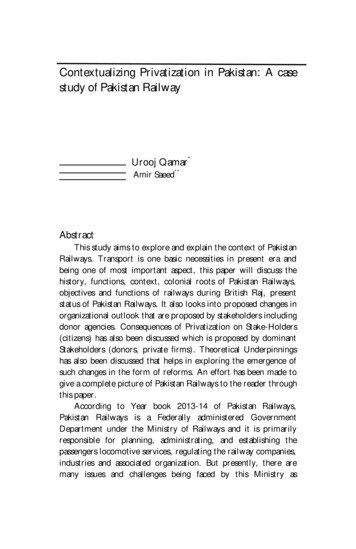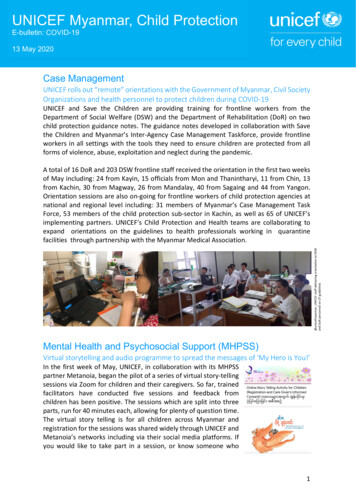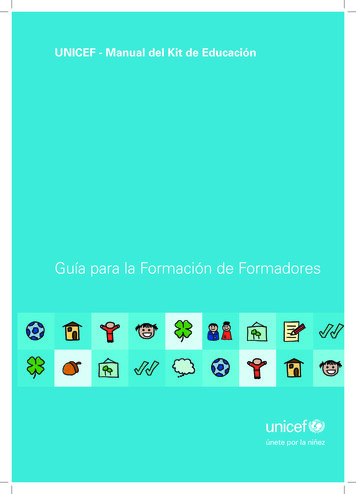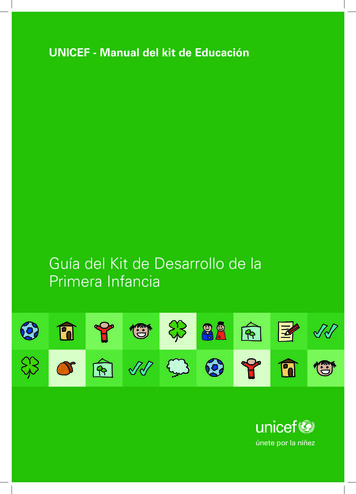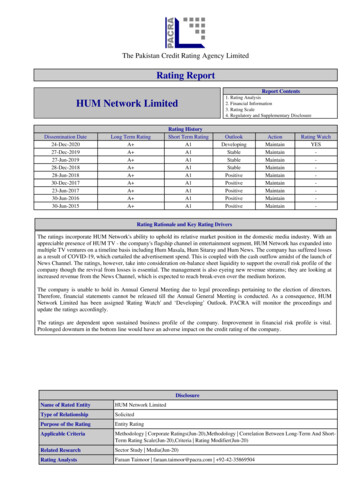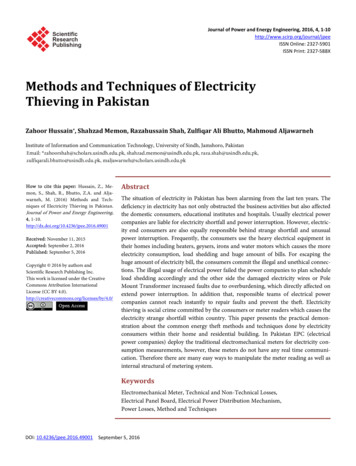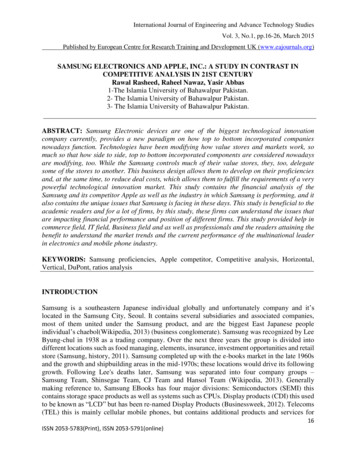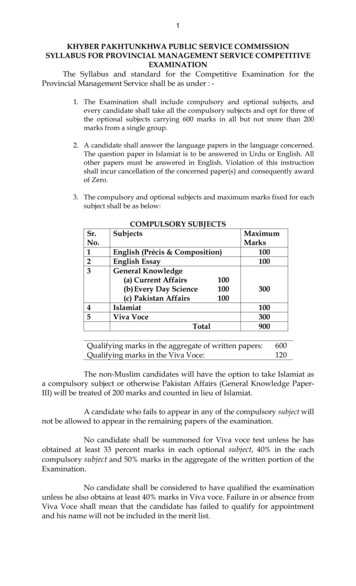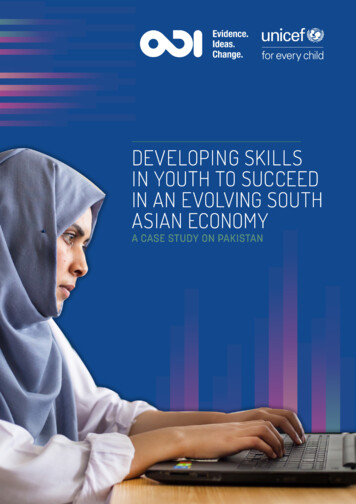
Transcription
CONTRIBUTORS OF THE REPORT:AMINA KHANMUHAMMAD USMAN KHAN &MARIA QUATTRIOCTOBER 2019 UNICEF PakistanPhotographs: UNICEF PakistanDesigned by Human Design Studios
ACKNOWLEDGEMENTSThis report was authored by Amina Khan, Senior Research Officer at the Overseas Development Institute(ODI), Muhammad Usman Khan, Economics Faculty (Lahore University of Management Sciences) and MariaQuattri, Research Fellow (ODI). The work was commissioned by UNICEF Pakistan.The authors would like to thank: the research team in Pakistan, Dr Sajid Amin (Sustainable DevelopmentPolicy Institute) in Islamabad, Ayesha Mysorewala in Karachi, Syed Basim Ahmed Ali in Lahore, and ShirazHasan in Peshawar, for conducting fieldwork in a short period of time in four locations; and researchers inODI (Soumya Chattopadhyay and Karishma Banga) and Tanvi Bhatkal (Cambridge University) for contributinganalysis for relevant sections of the study. The authors would also like to thank all the interviewees who gavetheir time and expertise to inform this study. The authors gratefully acknowledge the work of the ReferenceGroup members, whose inputs have been invaluable to informing the final study.Peer review was provided by Ellen Van Kalmthout, Anna Acker and Samuel Bickel (UNICEF), members ofthe Reference Group, and Aarti Krishnan and Susan Nicolai from ODI. The findings and conclusions of thisreport are those of the authors and do not necessarily reflect the positions or policies of ODI or UNICEF. Anymistakes remain the authors’ own.The suggested citation is:Khan, A., Khan, M. U. and Quattri, M. (2019) Developing skills in youth to succeed in an evolving South Asianeconomy – A case study on Pakistan, commissioned by UNICEF Pakistan. Islamabad: UNICEF.
FOREWORDA third of Pakistan’s population is between 15 and 29 years old and this age group is a key part of the country’sworkforce. A fundamental accelerator of the transitions from adolescence to youth to adulthood is economicsecurity, which means socially approved gainful employment in the job market to sustain oneself and a family.Each year, hundreds of thousands of Pakistani young people enter the labor market hoping to secure decentjobs and generate income for themselves and their families. However, young people are finding it difficult toaccess decent jobs.Many argue that youth have poor educational outcomes, limited skills and a lack of confidence to enter the jobmarket and succeed. Media stories about an “enormous skills gap” have stirred a debate within the countryabout the future of skills and the future of youth. Furthermore, the current macroeconomic environment isaffecting the private sector, which creates 90 per cent of jobs in the country.Given the size of the youth cohort in Pakistan, there is an urgent need to find paths for skill development atscale, to harness the potential demographic dividend. The Government of Pakistan has prioritized action foryouth, particularly youth employment and skilling, including through the National “Skills for All“ Strategy, andthe Kamyab Jawan Program launched in 2019.This study on developing skills in Pakistan’s youth to succeed in an evolving South Asian economy is thereforetimely. It aims to contribute to the evidence base on the skills ecosystem of Pakistan by asking three researchquestions: What is the demand for skilled workers? How is skills development organized? How can skillsdevelopment efforts be sustained?The Pakistan case study further feeds into a larger regional initiative led by UNICEF South Asia in collaborationwith the Global Business Coalition for Education to identify youth skills solutions which can be taken to scaleby governments in partnership with the private sector and frontline implementation partners.The study will also contribute towards the adaptation and implementation of Generation Unlimited (GenU) inPakistan. GenU aims to bring young people together with the private sector, governments, international andlocal organizations; it aims to connect secondary-age education and training to a complex and fast-changingworld of work, matching young people with job opportunities, fostering entrepreneurship and empoweringa generation to fully engage with their societies as active citizens.
I would like to thank the Overseas Development Institute (ODI) and its in-country research team from theLahore University of Management Sciences (LUMS) and Sustainable Development Policy Institute (SDPI) forauthoring this study. I gratefully acknowledge the work of the Reference Group members (including fromthe National and Vocational Technical Training Commission (NAVTTC), the Office of the Special Advisor to thePrime Minister on Youth Affairs, European Union, ILO, UNDP, and GIZ) whose inputs have been invaluable toinforming the final study.Young people in Pakistan require skills responsive to market needs from a range of sectors, includingmanufacturing and services, and that will allow them to thrive in an increasingly competitive global economy.Equally needed are skills that enable Pakistan’s youth to live to their full potential, to innovate, and createnew knowledge.Let us join hands in a partnership approach to engage Pakistan’s young people, to rally resources and tocoordinate efforts so that every young person will be in learning, training or employment.Aida GirmaRepresentativeUNICEF Pakistan
CONTENTS4210Section 4: How is skillsdevelopment organized?Executive summary4.1 Skills development in apolicy context 434.2 Skills development in a16delivery context 454.3 Challenges confrontingSection 1: Introductionskills development494.4 Opportunities for furtherskills development195457Section 2: Casestudy approach andmethodology2.1 Literature review202.2 Primary data collection212.3 Analysis and validation22Section 5: How can skillsdevelopment efforts besustained?5.1 Recent initiatives in youthskills development 595.2 Prevailing stakeholder perceptionson skills development2565Section 3: What is thedemand for skilledworkers?Section 6: Conclusionand recommendations3.1 Key labour force data273.2 Demand for skills293.3 Factors constraining the demand forskilled workers 373.4 Opportunities to raiseskills demand 3968References62
LIST OF FIGURES, MAPSAND TABLESFIGURES1. Informality in rural areas, in 2014/15 and 2017/18, and projections for 2020/21 (%)2. Informality in urban areas, in 2014/15 and 2017/18, and projections for 2020/21 (%)3. Employment by major industry division, in 2014/15 and 2017/18, and projections for 2020/21 (%)4. Employment by major occupations, in 2014/15 and 2017/18, and projections for 2020/21 (%)5. Overseas employment by skill level, 2014–2018 (%)6. Future skills demand within Pakistan’s IT industry7. Urbanization rates for the whole population and for youth (aged 15–24), 2005–2020 (%)8. Most important criteria for recruiting graduates (percentage of firms)9. Preferences for employability skills (percentage of respondents)MAP1. Industrial clusters in Pakistan and youth development in those areasTABLES1. Distribution of key informants by stakeholder category and location2. Employment sectors included in the analysis3. Labour force participation rates in 2014/15 and 2017/18, and projections for 2020/21 (%)4. Various occupational status indicators, 20185. Number of TVET institutions in Pakistan, 20186. Enrolment in TVET, by province7. Trades in high demand and the scale of shortages of skilled TVET graduates8. Trades in low demand and the scale of surplus skilled TVET graduates
ACRONYMSCAGRcompound annual growth rateCBTcompetency-based trainingCBT-Acompetency-based training and assessmentCPECChina Pakistan Economic CorridorEUEuropean UnionFTAfree trade agreementGIZDeutsche Gesellschaft für Internationale ZusammenarbeitICTinformation and communications technologyKIIkey informant interviewKPKhyber PakhtunkhwaLFPRlabour force participation rateNAVTTCNational Vocational and Technical Training CommissionNSISNational Skills Information SystemNTBNational Training BureauNVQFNational Vocational Qualification FrameworkOJTon-the-job trainingPKRPakistan rupeesPSDFPunjab Skills Development FundPSDPPunjab Skills Development ProjectSEZSpecial Economic ZoneSMEsmall or medium-sized enterpriseTEVTATechnical Education and Vocational Training AuthorityTVETtechnical and vocational education and trainingUNDPUnited Nations Development ProgrammeYEPYouth Employment Project (UNDP)
DEVELOPING SKILLS IN YOUTH TO SUCCEED IN AN EVOLVING SOUTH ASIAN ECONOMYEXECUTIVE SUMMARYA third of Pakistan’s population is between 15 and 29 years old (United Nations Development Programme, 2017)but the youth have poor educational outcomes, limited skills and lack the confidence to enter the job marketand succeed (Cheema, 2017; BR Research, 2019). Skills development therefore represents a key developmentagenda in Pakistan. This study aims to build a key part of the evidence base on the skills ecosystem by askingthree research questions: What is the demand for skilled workers? How is skills development organized? Howcan skills development efforts be sustained?WHAT IS THE DEMAND FOR SKILLED WORKERS?An in-depth literature review and key informant interviews with 75 stakeholders pointed to several keysources of demand for skilled workers.DEMAND IN SPECIFIC OCCUPATIONS: Workers have seen demand rise in specific skilled occupations.Between 2015 and 2018, employment grew by 14 per cent for plant/machine operators, 10.6 per cent fortechnicians and associate professionals, and 5 per cent for professionals and for craft/trade-related workers(Labour Force Survey, 2018). As for skilled graduates of technical and vocational education and training (TVET),three sectors generate the most demand annually: manufacturing, services and construction.AREA-SPECIFIC DEMAND FOR SKILLS: Industrial clusters in specific parts of Pakistan demand skills tofacilitate the development of related value chains (Burki et al., 2010). The areas where clusters are locatedrepresent higher density of employment demand where youth can go to explore job opportunities. Moreover,getting youth from local areas to respond to area-specific demand is one way to ensure their access to jobsand training. For instance, Lahore’s ready-made garments sector requires 26,000 skilled workers annually,including stitchers, designers and export officers (National Vocational and Technical Training Commissionand GIZ, 2017).DEMAND FROM CHINA–PAKISTAN ECONOMIC RELATIONS: The Pakistan Government has identifiednine priority Special Economic Zones (SEZs) under the China Pakistan Economic Corridor (CPEC) and anticipatedjob creation exceeding 800,000 (Government of Pakistan, 2018). The establishment, design and operationof SEZs will require several design engineers, construction workers, maintenance staff and security guards.CPEC and allied projects are also expected to create jobs for skilled female workers (National Vocational andTechnical Training Commission, 2019).DEMAND FROM THE INTERNATIONAL MARKET: In 2018, an estimated 382,000 skilled and unskilledworkers found jobs overseas (Bureau of Emigration and Overseas Employment, 2018). Of the variouscategories of workers that went abroad to work between 2014 and 2018, the sum of the shares of highlyqualified, highly skilled, skilled, and semi-skilled workers exceeded the share of unskilled workers. A highernumber of engineers, doctors, teachers and pharmacists migrated for work in 2018 than in previous years.Countries of the Gulf Cooperation Council continue to import a large amount of the country’s constructionworkers, engineers, customer service staff, drivers and workers in other elementary occupations (Bureau ofEmigration and Overseas Employment, 2018).10
DEVELOPING SKILLS IN YOUTH TO SUCCEED IN AN EVOLVING SOUTH ASIAN ECONOMYDEMAND FOR SKILLS FROM THE ICT SECTOR: Pakistan’s information communications technology (ICT)sector has grown significantly over the last 10 years and is carving a differentiated position as the preferredsource for software developers and programmers. Its formal IT exports have exceeded the value of US 1billion (of the total US 24 billion) and are expected to grow. A survey of over 300 IT firms located in 10 citiesof Pakistan (Pakistan IT & ITES Industry Survey, 2014) has identified mobile and web application developmentskills as key requirements for the future.URBANIZATION-RELATED DEMAND: Pakistan has one of the highest urbanization rates in South Asia –38.8 per cent in 2015 (United Nations, 2017). This has significantly increased the demand for skilled workers,including construction workers, drivers, cleaners, electricians, plumbers and service providers. Increasingpatches of urban pockets also boosted demand for commercial centres, banks and insurance facilities,creating further demand for skills (National Vocational and Technical Training Commission and GIZ, 2017). Inaddition to Karachi and Lahore, there are six more cities that have a population of more than a million people.This urban transition significantly impacts the demand for skills.CHALLENGES AND OPPORTUNITIES IN SKILLS DEMANDCHALLENGE 1. LOW-SKILLS TRAP: Pakistan is stuck in a low-skills trap where employers settle for thekind of low skills readily available in the market. Its failure to break away from its dependence on low-skills,low-technology manufactured exports has been because of its low level of human resource development(Amjad, 2005; United Nations Development Programme, 2017). In 2018, the illiteracy rate of the working-agepopulation (10 years or older) was 48.2 per cent (Labour Force Survey, 2018).CHALLENGE 2. INFORMATION GAPS IN THE LABOUR MARKET’S NEED FOR SKILLS: Informationgaps affect skills demand in several ways. Employers’ needs fail to reach potential employees and they arealso unable to find relevant and timely information about skilled applicants, including TVET graduates. Onlineportals such as ROZEE.pk are useful in that they hold thousands of CVs, but without adequate sorting andfiltering options, they make it difficult for recruiters and companies’ human resource departments to identifythe most relevant candidates (United States Agency for International Development, 2018b; 2018c). Employersinterviewed also raised concerns about the availability of timely information.OPPORTUNITY 1. TECHNOLOGICAL INNOVATION: Most of the employers interviewed acrossdifferent sectors in Karachi, Lahore and Peshawar anticipated that technological innovation would increasethe demand for highly skilled candidates. The anticipated impact on the demand for low-skilled workers wasmixed. In the pharmaceuticals sector, both the large- and small-scale employers considered technologicalinnovation would increase the demand for high-skilled candidates and reduce the demand for low-skilledworkers. However, several interviewees indicated that the relationship between employment and technologywould not necessarily be that simple.OPPORTUNITY 2. LABOUR MARKET RECOGNITION OF THE RELEVANCE OF EDUCATIONALATTAINMENT IN THE CONTEXT OF SKILLS ACQUISITION: Employers and industry associationsinterviewed across sectors attached varying levels of importance to education in skills development. Manyemployers highlighted the importance of basic education in terms of literacy as well as the development of11
DEVELOPING SKILLS IN YOUTH TO SUCCEED IN AN EVOLVING SOUTH ASIAN ECONOMYsoft skills such as computer literacy and communication skills. Whereas employers within sectors dependenton more traditional skill sets value technical skills over formal education, even within these industries (e.g.,gemstones) the introduction of technology will require workers with formal higher education qualificationsand IT skills.HOW IS SKILLS DEVELOPMENT ORGANIZED?Many actors engage in skills development in various capacities, including within contexts of policy and skillsdelivery.SKILLS DEVELOPMENT IN A POLICY CONTEXT: Governments – at both federal and provincial levels – playa vital role in skills development. At the federal level, the Ministry of Federal Education & Professional Trainingand the Ministry of Overseas Pakistanis and Human Resources Development play a key role. The NationalVocational and Technical Training Commission (National Vocational and Technical Training Commission),and the National Training Bureau (NTB) have been set up as bodies to steer the development of skills.NAVTCC has developed the ‘National Skills for All’ Strategy. Starting from 2019, it has guided interventionsin skills development in Pakistan and speaks to a wider skills development agenda, including making theNational Vocational Qualification Framework (NVQF) effective and implementing competency-based trainingand assessment (CBT-A). At the provincial level, Training and Vocational Education Authorities (TEVTAs) areresponsible for technical and vocational skills delivery and are also tasked to register private sector traininginstitutes and regulate them. Additionally, private providers are limited by the courses designed and approvedby TEVTAs. Across the provinces, certification agencies are generally separate for the two streams (UnitedStates Agency for International Development, 2018a).SKILLS DEVELOPMENT IN A DELIVERY CONTEXT: Skills development in a delivery context includes TVET,work-based learning, and informal training. There are over 3,500 TVET providers throughout the country’sprovinces and regions. In 2018, they enrolled just over 433,000 students (Skilling Pakistan, 2019). The deliveryfor the technical and vocational streams is managed through polytechnics, vocational training centres andapprenticeship schemes under the Apprenticeship Act, which makes it mandatory for industries to inductyouth for on-the-job training (OJT). However, this has been largely ineffective. Public sector providers outweighprivate providers in technical education. The reverse runs true for vocational training. Female enrolment inTVET is low in comparison to male enrolment (United States Agency for International Development, 2018a;2018b) and informal systems of apprenticeship, in comparison to TVET, tend to be more common in Pakistan(United Nations Development Programme, 2017).Challenges and opportunities in skills developmentCHALLENGE 1. MISMATCH BETWEEN DEMAND FOR AND SUPPLY OF SKILLED WORKERS: Thereis a strong disconnect between the demand from industries for specific types of skilled TVET graduatesand their supply. For example, in 2018, the demand for skilled graduates across Pakistan was highest formachine operators, stitchers and electricians (National Skills Information System, n.d.). But their supply12
DEVELOPING SKILLS IN YOUTH TO SUCCEED IN AN EVOLVING SOUTH ASIAN ECONOMYwas insufficient to meet this demand, and the deficit was sizeable. The supply of skilled TVET graduateswas highest for computer application and office professionals, tailors, beauticians, and electrical and civilengineering diploma holders but demand for their skills was low (National Skills Information System, n.d.).CHALLENGE 2. THE LACK OF SOFT SKILLS DEVELOPMENT: Employers find the lack of soft skills to be amajor issue in Pakistan and argue increasingly that these are more important than technical skills at entry level(United States Agency for International Development, 2018b). Employers look more closely at employabilityskills than academic qualifications received or academic institutions attended (Higher Education Commission,2016). The most important employability skills, in their view, are analytical, problem-solving, self-disciplineand people skills. All employers interviewed for this study agreed that, in general, neither public- nor privatesector providers focus on soft skills.CHALLENGE 3. THE RELEVANCE, QUALITY AND OUTCOMES OF TRAINING: Key informants acrossthe various stakeholder categories explained that training providers do not conduct meaningful marketresearch to inform course designs; they teach outdated and less market-relevant curricula, not suited toemployers’ needs. The training content does not expose trainees to entrepreneurship to the extent that itshould, so TVET graduates end up looking for jobs rather than moving into self-employment. The certificationsystem is non-uniform and does not provide credible signals to the labour market (United States Agency forInternational Development, 2018a).OPPORTUNITIES FOR FURTHER SKILLS DEVELOPMENTOPPORTUNITY 1. A GREATER EMPHASIS ON ENTREPRENEURSHIP: In recent years, the investmentin cultivating entrepreneurship has risen, especially in urban centres (United Nations DevelopmentProgramme, 2017). Top-ranking higher education institutions have established incubation centres. Thegovernment, private sector and international development partners also facilitate start-ups and help convertideas into business models. Training providers have a vital role in encouraging entrepreneurship. Some are:embedding an ‘entrepreneurship’ approach in their curriculum; mentoring students; hosting teacher-ledworkshops; offering networking opportunities with the business community; and acting as intermediariesbetween donor agencies and government departments that have loan schemes available for their students.OPPORTUNITY 2. A GREATER ROLE FOR EDUCATION IN SKILLS DEVELOPMENT: There is a greaterneed and role for education in skills development and for producing quality young students who are fitto meet labour-market demands and who can improve their development outcomes. Pakistan’s educationsystem needs to focus on skills that enhance cognitive development and analytical and critical thinking (UnitedNations Development Programme, 2017). And unless Pakistan develops closer collaboration between thevarious systems – primary, secondary, higher level, vocational and skills training – there is a risk that the youthwill not be fit for the future world of work. Greater linkages between the education system and industry arealso needed.OPPORTUNITY 3. A CONCENTRATED EFFORT TO CREATE MORE SKILLED FEMALE WORKERS:Skills development focused on women can help them become more independent intellectually as well asfinancially. Multifaceted approaches to professional training can help women overcome traditional barriers13
DEVELOPING SKILLS IN YOUTH TO SUCCEED IN AN EVOLVING SOUTH ASIAN ECONOMYto career growth. Such approaches would include vocational programmes and awareness campaigns aboutwomen’s legal rights at work, and how to access markets for quality employment and form interpersonalrelations that encourage greater empowerment (United Nations Development Programme, 2017).HOW CAN SKILLS DEVELOPMENT EFFORTS BE SUSTAINED?Public sector initiatives in youth skills development are largely undertaken in collaboration with internationaldevelopment partners. This study discusses three examples: the TVET reforms launched by the EuropeanUnion (EU); the Youth Employment Project (YEP) of the United Nations Development Programme (UNDP); andthe Punjab Skills Development Project (PSDP), a provincial government initiative with loan assistance fromthe World Bank. The cases highlight variations across TVET outreach and service delivery. Whereas the EUfunded TVET phases have nationwide outreach, the UNDP project is limited to one city (Karachi) and the WorldBank project focuses on skills development in Punjab. Relative strengths pertain to phased development inthe case of the EU-funded project, with an opportunity to reflect on lessons learned during each stage of TVETdesign and service delivery including the development of relevant skills-related policies and strategies. TheUNDP project addresses location-specific youth employment challenges with an emphasis on gaining sectorrelated skills. The ongoing World Bank project emphasizes institutional strengthening in Punjab to encouragecompetition among, and growth of, training providers.While public sector entities have a wide outreach with respect to skills development training, much remains tobe done in terms of bringing about long-term changes. Key informants from the public sector draw attentionto inter-departmental as well as cross-sectoral cooperation along with political will to enable effective skillsdevelopment among youth. The government’s critical role is underscored, especially for replicating and/orscaling up projects. It is acknowledged that, while donors can design and implement pilot measures, theycannot cover an entire sector. Necessary funding from the government ‘with full ownership’ is integral toachieving sustainable solutions.RECOMMENDATIONSSTRENGTHEN LINKAGES ACROSS KEY ACTORS Develop greater linkages between skills providers, academia and industries to help bridge the gapbetween the kind of skills employers want and the training both public and private sector institutes aretable to provide. Integrate TVET in secondary schools and add subjects that will equip students with more employableskills from an early age, prior to them entering the workforce. Improve communication among key actors. This will enable TVET providers to train youth for jobswhere skills requirements change quickly. This will also allow employers to inform the curriculum ofTVET. Address information failures in the labour market to improve links between employers and skilledworkers (including career counselling services), as well as increasing the use of ICT-based job portals.14
DEVELOPING SKILLS IN YOUTH TO SUCCEED IN AN EVOLVING SOUTH ASIAN ECONOMYFAST-TRACK POLICY IMPLEMENTATION Pursue implementation of the ‘Skills for All’ road map for skills development, notified by theGovernment of Pakistan and presented in the Cabinet, which explicitly lays down measures forsustainability. Address coordination failures within and across institutions engaged in skills development, fromboth policy and delivery contexts. Reviewing Punjab’s model of separating regulatory, training andassessment functions of the various public agencies engaged in skills development would be a usefulstart. Build a positive image of TVET and consolidate scattered training institutions, to encourage investmentsin TVET. Integrate skills development within all major economic growth and industrial policies, so that this feedsinto the broader growth agenda.IMPROVE QUALITY AND RELEVANCE OF SKILLS TRAINING Support the creation of a unified and accredited qualification-awarding system. This system shouldensure timely issuance of credible and authentic national certificates and be accepted nationallyand internationally. Similarly, support the promotion of a quality assurance culture in training deliveryand assessment. Expand industry engagement in the skills sector to address the issues of training relevance and quality.Public–private partnerships are critical in the development of high-quality TVET because they enableregular communication between employers and TVET providers. It is equally important for industries todevelop skills within their workforces. Invest in research to assess the demand for skills and to help inform the design of relevant trainings tomeet the demand.LEAVE NO ONE BEHIND IN THE SKILLS DEVELOPMENT AGENDA Lay greater emphasis on a skills development agenda for women to increase their prospects to applyand secure potentially higher-paying jobs. Address disparities in access to training among social groups such as those from rural areas and thosesusceptible to exclusion from the training and broader education systems. Reduce informality in the training structure and in the composition of employment, as it is associatedwith poor working conditions, low wages and a low-level skills trap young people may find increasinglyhard to escape. Create a skilled workforce able to seize employment opportunities abroad and send remittances thatcould improve Pakistan’s economic situation, and ensure their rights as migrants are protected indestination countries.15
DEVELOPING SKILLS IN YOUTH TO SUCCEED IN AN EVOLVING SOUTH ASIAN ECONOMYSection 1INTRODUCTION16
Section 1DEVELOPING SKILLS IN YOUTH TO SUCCEED IN AN EVOLVING SOUTH ASIAN ECONOMYINTRODUCTIONA third of Pakistan’s population is between 15 and 29 years old (United NationsDevelopment Programme, 2017), and this age group is a key part of the workforce.Each year, hundreds of thousands hope to secure decent jobs and generate income forthemselves and their families. But the current macroeconomic environment is affectingthe private sector, which creates 90 per cent of jobs in the country (Government of thePunjab, 2019), and young people are finding it difficult to access decent jobs.Many argue that youth have poor educational outcomes, limited skills and a lack ofconfidence to enter the job market and succeed (Cheema, 2017; BR Research, 2019).The lack of skills especially “handicaps the youth in terms of equitable access to qualityjob markets and reduces the chances of breaking cycles of low development” (UnitedNations Development Programme, 2017: 87). Media stories about an “enormous skillsgap” (Jamal, 2015) and a “national emergency on skills development in Pakistan” (BRResearch, 2019) have stirred a debate within the country about the future of skills andthe future of youth.This study on developing skills in Pakistani youth to succeed in an evolving South Asianeconomy is therefore timely. The young in Pakistan – the second most populous countryin the region – need to develop skills that are responsive to market needs from a rangeof sectors, including manufacturing and services, and that allow them to thrive in anincreasingly competitive global economy. Equally needed are skills that enable themto lead lives that they have reason to value (Sen, 1999), to innovate, and create newknowledge. Consequently, it is crucial to identify where future job opportunities foryouth can come from and to take a proactive role in building their skills so that they canbecome more employable and seize those opportunities.Against this backdrop, skills development represents a key development agenda inPakis
Policy Institute) in Islamabad, Ayesha Mysorewala in Karachi, Syed Basim Ahmed Ali in Lahore, and Shiraz Hasan in Peshawar, for conducting fieldwork in a short period of time in four locations; and researchers in ODI (Soumya Chattopadhyay and Karishma Banga) and Tanvi Bhatkal (Cambridge University) for contributing

